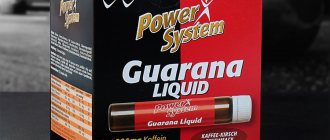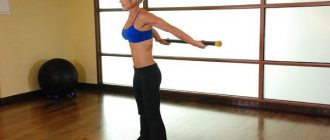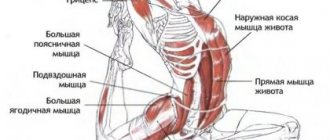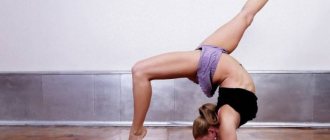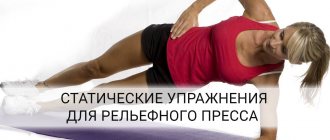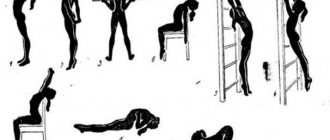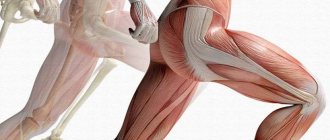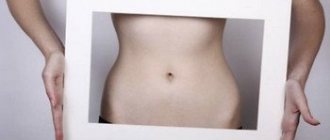Author: Timko Ilya - the ruler of the entire site and fitness trainer | more details >> Rod. 1984 Trained since 1999 Trained since 2007. Author and creator of the site tvoytrener.com. CCM in powerlifting. Champion of Russia and South Russia according to AWPC. Champion of the Krasnodar region according to IPF. 1st category in weightlifting. 2-time winner of the Krasnodar Territory championship in t/a. Author of more than 700 articles on fitness and amateur athletics. Author and co-author of 5 books.
Place in the author rating:
out of competition
(become an author)
Date:
2019-05-27
Views:
3,343
Rating:
4.0
| All articles by the author >> | Medals articles >> |
Articles are loading...
Quite often I am asked this question. Most of these questions are related to the asymmetry of the arms and legs. That is, one leg or arm is thicker than the other. They also often write about the different sizes of the pectoral muscles. Less commonly, there is a difference in the back (latissimus muscles). Even less common are the shoulders. But, one way or another, asymmetry can affect all paired muscles. As for the difference in arms and legs, almost everyone has it. And the reason for this is the most common cause of asymmetry, which will be discussed below.
Muscle asymmetry[edit | edit code]
EMG scans: normal on the left
Many novice bodybuilding athletes are faced with the problem of muscle asymmetry. This condition is characterized by the fact that the muscles on one side of the body differ in shape and size from the same muscles on the opposite side. For example, the left biceps is less developed than the right biceps.
Asymmetry is quite common, and if you take a closer look at your body, you may also notice some differences between the left and right sides of the body. Almost all people have different arm lengths, eye shapes, shoulder and ear heights, hip positions, etc. Usually, you don't notice this because people rarely take a straight standing position.
So how do you correct asymmetry?
The tactics will depend largely on the root cause of your problem. Most often people encounter it when they have a disease such as scoliosis. This is a condition in which there is a curvature of the spine that is practically impossible to correct with physical exercise. However, visible asymmetry can be eliminated by strengthening the muscular-ligamentous corset. In addition, this will eliminate or reduce pain. In this situation, bodybuilding classes (consultation with a doctor is required to exclude contraindications) and special gymnastics will be useful.
True muscle asymmetry develops for unknown reasons, but it can be corrected. Most often, differences are observed in the size and shape of the pectoral and abdominal muscles. To eliminate this condition, you need to follow these recommendations:
- Increase muscle mass, as the differences will level out. This is the main way to combat this problem.
- Try to consciously place more load on lagging muscles.
- If there is asymmetry of the pectoral muscles, you can perform exercises with a barbell (bench press), while the total weight of the discs on the lagging side should be about 5-10% more. The same technique can be used with dumbbells. You can also move the arm with the smaller biceps (if you are doing biceps curls while standing) closer to the center of the bar while leaving the other arm with a more pronounced biceps in its usual place.
- Perform predominantly unilateral exercises - this will isolate one side of the body from the other. Use dumbbells, single cables, and any equipment that will help you focus on the weakest side of your body. Also, if possible, avoid machines and use free weights more.
- Adjust the number of repetitions of the exercise according to your weakness. It is necessary to start the exercise with the lagging part and perform it until it (for example, the weak left hand) fails, while the right one can still perform it, but the approach must be completed. As a result, the dominant side will be slightly undertrained, which will allow the lagging side to progress and catch up.
- The correct form of performing exercises, taking into account anatomical features, will correct asymmetry. Pre-warm up the muscles and cool down/stretch at the end of the workout, paying special attention to the weak side.
- Strengthening internal muscles and ligaments
Method not working
At the end of the article I would like to touch on one way to eliminate asymmetry, which, in my opinion, does not work at all, but which for some reason is recommended by many trainers and bloggers. And this is what they advise:
Place more weight on the lagging side.
For example, if your left arm lags behind, and you do curls with dumbbells, then take an 18 kg dumbbell in your right hand, for example, and a 20 kg dumbbell in your left hand. That is, these people advise you to take more weight on the weaker side! Well, how does your weaker hand lift a dumbbell that is heavier than in your stronger hand? No way! More precisely, it will lift, but if with your right hand you lift 18 kg 12 times, then with your left hand – 20 kg 6 times. And if it’s more, then with such a clumsy technique, which will be of little use. Well, the question is, why did everyone suddenly decide that this method would work? It won't work.
Back muscle asymmetry[edit | edit code]
As a rule, back asymmetry is a consequence of another pathology - scoliosis
. The S-shaped curvature of the spine gives visual disproportion to the back muscles, but the reason lies in the curvature of the spinal column. Often, scoliosis leads not only to disruption of the symmetry of the back, but also of the pectoral muscles, as well as the leg muscles due to disruption of the biomechanics of movement and uneven distribution of the load.
In this situation, it is recommended (if the curvature of the spine is not severe and there are no contraindications):
- Regular strength training to strengthen the muscle corset
- Step-by-step posture correction program
What facial asymmetry can gymnastics overcome?
Let's look at the reasons for this phenomenon. Traditionally they are divided into 2 parts.
1. Congenital
If the bones of the jaw, skull, facial joints, connective or muscle tissue develop incorrectly, this leads to distortion of features.
If the distortion is small, hairstyle and makeup for a woman, beard and mustache for a man will help make it invisible.
In other cases, correction in the form of surgery will most likely be required. Modern plastic surgery works wonders and can fix almost anything.
2. Purchased
Here, the source of asymmetry in an adult or child can be injury, improper “ownership” of one or another part of the face, or disease. Most often this is:
- the result of severe strabismus;
- inflammation of the facial nerve, which can occur from walking without a hat in winter, from a draft in summer, or even from stress;
- clamping of a nerve fiber, for example, due to a stroke - and it must be said that today it can occur not only in an old person, but even in a teenager;
- dental problems, when the entire row of teeth in the jaw is missing, or an incorrect bite has developed;
- fractures of the jaw and other facial bones, their improper fusion;
- torticollis in children;
- incorrect habits and facial expressions, when a person chews exclusively on one side or always sleeps in the same position, or regularly squints with one eye.
What to do if a stroke or nerve inflammation has caused part of the face to lose sensation and a clearly visible curvature?
First of all, we go to the doctors to accurately determine the cause and agree on treatment.
You should consult with the following specialists:
- dentist;
- orthodontist;
- ophthalmologist;
- maxillofacial surgeon;
- neuropathologist.
If surgical correction of the pathology is not prescribed, massage and special facial exercises will most likely be indicated, which I want to tell you about in as much detail as possible in this article.
Causes of scoliotic
To date, a number of reasons have been identified why scoliotic posture occurs even in a child. Among the most common factors are the following:
- Birth injuries. As a result of birth injuries, the normal development and growth of the spinal column is disrupted, which leads to the development of scoliotic posture in the child;
- Consequences of surgery. Scoliotic posture can be caused by complications after spinal surgery;
- Serious diseases of internal organs;
- Pathologies of spinal development;
- Muscle dysfunction and weakening of the muscle corset;
- Infectious diseases can provoke true shortening of one of the lower limbs, which ultimately leads to scoliotic posture in the child.
- The appearance of scars in the back area, which appear as a result of burns.
Despite the fact that there are many different reasons and irritating factors that provoke the occurrence of scoliotic posture in a child, parents should pay great attention to school-age children. After all, it is during this period that the child’s spine is most susceptible to pathological changes due to prolonged sitting at a desk and not always in the correct position.
What Causes Muscle Imbalance
There is no such thing as a perfectly symmetrical body. Genetics influence muscle strength and susceptibility to hypertrophy, but other factors play a major role in causing imbalances.
Poorly designed program or lack thereof
Men often prefer to pump up their chest, shoulders and arms, while forgetting about their back and legs. Women pay all their attention to their legs and buttocks, being afraid to do exercises on their arms and shoulders so as not to “become a jock.”
As a result, both of them end up with muscle imbalance and an asymmetrical body that is far from ideal.
Lack of attention to technology
If you do not follow the correct technique during the exercise, the load may shift to one side.
Let's say your back muscles are more developed on the right side. When you do bent-over dumbbell rows with your right hand, your back muscles can withstand the load and you are using proper technique. On the left side, weak back muscles quickly give way, and the load shifts to the shoulders.
If you do not pay attention to this, the muscles on the right side will become increasingly stronger, a noticeable muscle imbalance will appear and the risk of injuring the shoulder will appear.
Insufficient joint mobility
Many people spend all day at their desks maintaining poor body posture. This causes the muscles to tighten, become stiff and limit the mobility of the joints.
The body compensates for lack of mobility with poor technique. As a result, some muscles receive too much load, while others are practically not involved in the movement.
What other reasons could there be?
You need to start sounding the alarm when a woman has long since left adolescence and is not breastfeeding, but she still has breast asymmetry. Here the reason, of course, may be a normal hormonal imbalance due to constant stress, fatigue, etc., then you should consult an endocrinologist. After conducting the appropriate tests, he will be able to identify what exactly the problem is and prescribe a course of treatment. But it can also be more serious - tumors. Then a visit to the doctor cannot be postponed. With such symptoms, they turn to a specialist in the mammary glands, namely, a mammologist, who, during the examination, will identify the causes and, if necessary, prescribe a course of treatment.
If no serious health problems have been identified, you should not focus on it, because usually this problem is so insignificant that no one notices it.
Clinical manifestations
As mentioned earlier, parents should pay great attention to their child, that is, constantly monitor his posture and examine his appearance from time to time. Indeed, in any case, the first signs of a disease such as scoliotic posture are quite clearly visible upon external examination. But at the same time, there are other symptoms that indicate the appearance of spinal deformity. These include:
- Asymmetry of the shoulders and shoulder blades;
- Shortening of one of the lower limbs;
- Changes in the anatomical position of the child’s pelvis;
- Head displacement to one side;
- Changes in the anatomical curves of the spine;
- External changes in which the displacement of the lumbar vertebrae is clearly visible along with the opposite deformation in the thoracic spine.
The severity of the symptoms of the disease always depends on the degree of curvature of the spinal column. Therefore, at the first sign of a violation of the anatomically correct position of the spine, you should urgently contact specialists for help. After all, only timely treatment can eliminate the resulting displacement of the vertebrae and prevent further development of the disease.
What is muscle imbalance
Almost all skeletal muscles in our body are paired and located symmetrically - on the right and left.
Muscle imbalance is a violation of symmetry, a discrepancy in the size and strength of paired muscles or muscle groups. In some cases, an imbalance can be noticed, for example, when one arm or pectoral muscle is noticeably larger than the other, in others the difference is not so obvious, but is felt during training.
For example, if one arm is stronger than the other, the bar may tilt to one side during a bench press because the stronger arm will push it up faster.
Imbalances can also occur between major muscle groups, such as the back and chest, triceps and biceps, upper legs and calf muscles.
Not only does it look bad and reduce athletic performance, but it can also lead to injury. For example, if an athlete has a pumped chest and poorly developed back muscles, this increases the risk of injuring the shoulders.
In addition, muscle imbalance leads to poor posture. For example, weak back extensors and tight, clenched abdominal muscles are characteristic of a slouched posture, while tight hip flexors can cause an excessive arch in the lower back.
Diagnosis and treatment
As you know, any process of pathological changes in the spine, including scoliotic posture, has its own reasons. Therefore, at the first symptoms of the disease, it is necessary to conduct a thorough examination to establish a diagnosis and identify irritating factors. In the case of the appearance of scoliotic posture, an external examination of the patient is performed in the hospital and radiography is used to clarify the degree of curvature of the spine.
After clarifying all the necessary points, a comprehensive treatment is prescribed, which includes the following procedures׃
- Wearing a special corset that fixes the correct position of the spine and relieves muscle strain in the damaged area of the back.
- Massage can improve blood circulation, strengthen the muscle corset and establish metabolic processes in the body. Most often, this procedure is used in combination with therapeutic exercises. Since after performing special exercises, massage makes it possible to relax the back muscles and consolidate the effect after exercise therapy.
- Manual therapy should only be performed by specialists. After all, such a procedure requires special skills and precise knowledge to eliminate pathological changes in the spine.
- Physiotherapy improves blood flow in the spinal column, improves the functioning of internal organs and normalizes the patient’s general condition.
- Swimming also has a beneficial effect on the process of restoring a child's health.
Despite all the necessary procedures in the hospital, parents must constantly monitor the child’s posture, because often, when they come home, children sit at a desk without noticing the constant curvature of the spine. It is also worth choosing the right mattress and pillow for sleeping, which will allow you to control the correct position of the spinal column and prevent circulatory problems. For a speedy recovery, parents should replenish the child’s body with vitamins. This will improve the child’s immunity and improve all metabolic processes in the body.
It can be noted that the most effective way to eliminate spinal deformation, which causes scoliotic posture, is therapeutic exercises. A special set of exercises is developed only by a specialist for each patient individually. After all, any case of the occurrence of such displacements has its own characteristics. But there are also general exercises that are used in the treatment of scoliotic posture in a child.
SPORT CLUB
As you know, the main goal of bodybuilding is not to gain huge muscle mass, but to develop a harmonious and proportional physique. Some coaches argue that it is necessary to eliminate obvious imbalances at the very beginning of the training journey. Naturally, it is more rational to start with the most problematic areas, so that the existing disproportion does not become even more pronounced. At the same time, it is not recommended to deviate from the planned training plan; you just need to make certain amendments that will help correct physique flaws.
Upon closer examination of the physique of any person with a central axis of symmetry, you will notice that in fact he is not entirely symmetrical. Even the location of the internal organs testifies in favor of this statement. When we talk about skeletal muscles, we are talking about the differences between the right and left sides of the body. For example, the working or main arm may be larger in cross-section than the other arm. A similar situation is observed in relation to the lower extremities. Most often, the circumferences of the thigh, biceps, and lower leg, which are measured with muscle tension at the widest point, are different for the right and left half of the body. As a rule, the deviation is insignificant, on average it is 0.5-1.5 centimeters. Visually, these differences are invisible even to an experienced eye, and therefore are considered normal.
The situation is completely different if the imbalance in the right and left muscles of the same name is clearly noticeable, and the measurements taken confirm this fact. Although there are some details here too. For example, when comparing muscles by reflection in a mirror or in a photo, you should understand that factors such as the shooting angle, the degree of tension, the chosen pose and the direction of lighting play a role here. It is completely illogical to compare muscles of the same name under different conditions. This principle applies mainly to the muscles of the legs and arms.
Asymmetry often appears in the muscles of the back or chest, in most cases this indicates scoliosis, stooping or curvature of the spine. Such disorders can be caused by the greatest physical activity of one of the hands. When identifying problems with the spine, in order to eliminate asymmetry, it is important to act not on the effect, but on the root cause.
So-called unilateral training is often used to specifically eliminate the asymmetry of the muscle groups of the right and left halves of the body. In other words, the exercises are performed separately for each side. For this purpose, exercises that are performed alternately in a separate approach, or those that alternate the load on different halves from approach to approach, are suitable. For example, leg extensions in the simulator can be performed not with two legs at a time, but with one leg. Also, exercises for small muscle groups (shoulders, triceps, biceps) can be performed with dumbbells for each half of the body separately. It is worth noting that with the same weight you can perform different numbers of repetitions for the right and left muscle groups. In some cases, different working weights are chosen for each half to correct symmetry. In any case, most problems are best resolved under the guidance of an experienced trainer.

